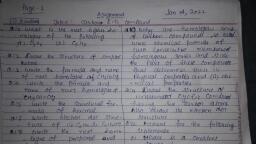Question 1 :
Which of the following is a monounsaturated hydrocarbon, i.e. the compound that contains one carbon - carbon double bond?
Question 5 :
Which of the following reagent reacts with ethanoic acid to liberate hydrogen gas?<br/>
Question 7 :
Compounds of carbon and hydrogen which form long chains or branched chains are:
Question 9 :
In which of the following species the bonds are non directional?
Question 10 :
<p class="MsoNormal">Temporary hardness can be removed by mixing water with slaked lime, this process is known as softening of water.</p>
Question 12 :
The organic compounds having double or triple bond(s) in them are termed as ________________.
Question 13 :
Observe the following pairs of organic compounds:<br/>(I) $C_{4}H_{9}OH$ and $C_{5}H_{11} OH$<br/>(II) $C_{7}H_{15}OH$ and $C_{5}H_{11} OH$<br/>(III) $C_{6}H_{13}OH$ and $C_{3}H_{7}OH$<br/>Which of these pairs is a homologous series according to increasing order of carbon atom?<br/>
Question 15 :
How many carbon atoms are present in a molecule of nonane?
Question 16 :
When 2 hydrogen atoms combine to form $H_2$ molecule, the system ______ .
Question 17 :
Statement I: Water is a polar molecule.<br/>Statement II:  Water has polar covalent bonds.<br/>
Question 21 :
The phenomenon of existence of an element in more than one physical form is called allotropy.<br/>
Question 22 :
Fullerene, an allotrope of carbon, has 60 carbon atoms joined together and no other element in it. There are various types of fullerenes. $C_{60}, C_{70}, C_{74}$ and $C_{78}$ are the members of the fullerene family. Identify the property due to which such large numbers of carbon atoms are joined together in this molecule :
Question 26 :
Which of the following system has maximum number of unpaired electrons?
Question 31 :
Methane, ethane and propane are said to form a homologous series because all are:<br/>
Question 33 :
The carbon atoms in diamond are bonded to each other by:
Question 36 :
Which of the following is the true statement for carbon atoms :<br/>
Question 37 :
Hydrocarbons are the organic compounds that contain the elements _______ and ________.
Question 40 :
Which of the following pairs are members of a Homologous series?
Question 41 :
The most common reactions of homologous series increase the number of :
Question 43 :
Compounds within a homologous series typically have a fixed set of :
Question 48 :
<p>Which of the following does not belong to the same homologous series?</p><p>(1) $ C_{4}H_{10} $  (2) $ C_{2}H_{6} $  (3) $ C_{3}H_{8} $  (4) $ C_{4}H_{8} $</p>
Question 49 :
The formation of chains by atoms of the same element is known as:
Question 53 :
The general molecular formula, which represents the homologous series of alkanols is :
Question 54 :
Which of the following not a member of homologues series :
Question 56 :
Assertion: Detergents are better cleansing agents than soaps.
Reason: A soap contains a $COO-$ group, which is capable of dispersing the attractive forces between water molecules, known as "surface tension", but will not be able to do this indefinitely. Detergents on the other hand contain an $O-SO_3-$ group with the same ions which can hold this force at bay.
Question 60 :
$C_6H_{12}$ and $C_6H_6$ are the examples of aromatic and aliphatic hydrocarbons respectively.<br/><br/>
Question 61 :
LPG is liquefied petroleum gas which is a compound of butane and propane and used as :
Question 62 :
The number of free electrons in the outermost shell of carbon in graphite is:
Question 68 :
The % by volume of $C_{4}H_{10}$ is a gaseous mixture of $C_{4}H_{10}, CH_{4}$ and $CO$ is $40$. When $200\ ml$ of the mixture is burnt in excess of $O_{2}$, Find volume (in ml) of $CO_{2}$ produced :
Question 71 :
Which of the following does not decolourise bromine solution in carbon disulphide
Question 76 :
${ \left( { CH }_{ 3 } \right) }_{ 3 }CMgBr$ on reaction with ${ D }_{ 2 }O$ produces:
Question 77 :
Successive members of homologous series differ form one another in their mass by :
Question 78 :
<p>Identify the unsaturated compounds from the following -</p><p>(a) Propane (b) Propene</p><p>(c) Propyne (d) Chloropropane</p><p>(1) (a) and (b) (2) (b) and (d)</p><p>(3) (c) and (d) (4) (b) and (c)</p>
Question 81 :
Hydrocarbon containing minimum mass % of carbon will have which of the following characteristics?
Question 82 :
The IUPAC name of the complex $\left[ Cr{ Cl }_{ 2 }{ \left( { H }_{ 2 }O \right)  }_{ 4 } \right] N{ O }_{ 3 }$ is :
Question 83 :
Find the appropriate match for column A from column B and arrange them from (i) to (iv) in order.
Question 84 :
Which chemical substance is emitted in car exhaust and is a cause of acid rain?
Question 87 :
Which of the following types of reactions occur when a hydrocarbon has a double bond?
Question 90 :
When most fuels burn, the products include carbon dioxide and X. What is X?<br/>
Question 91 :
Which of the following statements is wrong for a homologous series?
Question 95 :
Which of the following order regarding the sizeof hybrid orbital of carbon is correct?<br>
Question 97 :
Assertion : The element carbon forms the basic structural framework of more compounds than any other element<br/>Reason : The carbon-carbon bond is ionic.<br/>
Question 99 :
Chemically similar compounds differing by -$\displaystyle { CH }_{ 2 }$ unit are called :
Question 100 :
Information about four hydrocarbons is shown.<br><table class="wysiwyg-table"><tbody><tr><td>hydrocarbon</td><td>number of carbon atoms<br>in the molecules</td><td>reaction with bromine<br>water</td></tr><tr><td>W</td><td>1</td><td>no reaction</td></tr><tr><td>X</td><td>2</td><td>no reaction</td></tr><tr><td>Y</td><td>3</td><td>decolourises it</td></tr><tr><td>Z</td><td>4</td><td>decolourises it</td></tr></tbody></table>Which statement is correct?
Question 101 :
Consider the following statements : A hydrocarbon of molecular formula $C_{5}H_{10}$ is a:<br>I. monosubstituted alkene<br>II. disubstituted alkene<br>III. trisubstituted alkene
Question 104 :
Which of the following is more reactive towards nucleophilic addition reactions?
Question 105 :
Which of the following compounds have been named correctly according to IUPAC rules: <br/>(a)$[Cr(NH_3)_5CO_3]Cl$   -  Pentamminecarbonatochromium (III) chloride<br/>(b)$[Co(NH_3)_5ONO]Cl_2$  -  Pentammine-O-nitritocobalt (III) chloride<br/>(c)$K_3[Cr(CN)_6]$ -  Potassium hexacyanochromate(III)<br/>(d)$[Co(NH_3)_6]Cl_3$  - Hexamminecobalt (III) chloride<br/>
Question 106 :
Select the correct order of decreasing reactivity of the following compounds towards the attack of Grignard reagent.<br/>(I)Methyl benzoate (II) Benzaldehyde (III)Benzoyl chloride (IV)Acetophenone
Question 107 :
A hydrocarbon has molecular formula $C_4H_6$. Which of the classof hydrocarbonscannot have this formula?
Question 109 :
Which gas is produced when compound $X$ reacts with washing soda?
Question 111 :
A compound $X$ is obtained by the reaction of alkaline $KMnO_4$ with another compound $Y$ followed by acidification. Compound $X$ also reacts with compound $Y$ in presence of few drops of $H_2SO_4$ to form a sweet smelling compound $Z$. The compound $X$, $Y$ and $Z$ are respectively :
Question 113 :
The correct order of increasing covalent character of the following is:
Question 114 :
Which of the following is the most suitable method for removing the traces of water from ethanol?
Question 117 :
The $IUPAC$ name of $\displaystyle K_{4}\left [ Fe\left ( CN \right )_{6} \right ]$ is:
Question 118 :
The complex ion in the compound $\displaystyle Cs\left [ MnF_{4}\left ( H_{2}O \right )_{2} \right ]$ is octahedral and high spin. The name of the compound is :
Question 120 :
The most susceptible to nucleophilic attack at the carbonyl group among the given compound is:
Question 121 :
In an ionic compound $A^+$ $X^-$ the degree of covalent bonding is greatest when :
Question 122 :
Among the following, the surfactant that will form micelles in aqueous solution at the lowest molar concentration at ambient conditions is :
Question 124 :
Select the correct I.U.P.A.C. name for [(C$_6$H$_5$)$_3$P $Cl$ Pd Cl$_2$ Pd $Cl$(C$_6$H$_5$)$_3$P] 
Question 126 :
The end product $'C'$ in the following sequence of chemical reactions is:<br/>$CH_{3}COOH \xrightarrow {CaCO_{3}} A \xrightarrow {Heat} B\xrightarrow {NH_{2}OH}C$.
Question 129 :
The ratio of number of lone pairs in $NH_3$, $H_2O$ and $XeF_{2}$ is :
Question 132 :
How many hydrogen atoms would you expect to find in a saturated hydrocarbon with 7 carbon atoms?
Question 133 :
Propylsulphinic acid is prepared by the reaction of the following, followed by hydrolysis:
Question 135 :
Select the correct I.U.P.A.C name for $Mo(\sigma - C_3H_5)(\pi - C_5H_5)(CO)_3$ :<br>
Question 136 :
A mono-acid organic base gave the following results on analysis. C = 78.6% H = 84% N = 13%. 0.4 gm of the platinic chloride left on ignition 0.125 gm of pt. The molecular formula of the base is:<br/>
Question 137 :
Assertion: Small quantity of soap is used to prepare a stable emulsion.
Reason: Soap lowers the interfacial tension between oil and water.
Question 138 :
Assertion: Saturated hydrocarbons are chemically less reactive.
Reason: All isomeric paraffins have same parent name.
Question 139 :
An organic compound 'A' produces a gas with brisk effervescence when sodium bicarbonate is added to it. The compound 'A' contains same number of carbons as in ethane. The compound 'A' reacts with ethanol to form a sweet smelling compound 'C' in presence of conc. $H_2SO_4$. A and C respectively are :
Question 140 :
The IUPAC name for the complex $\displaystyle \left [ Co\left ( NH_{3} \right )_{5}\left ( NO_{2} \right ) \right ]Cl_{2}$ is:
Question 141 :
A student takes about 4 ml of distilled water in four test tubes marked $P, Q, R$ and $S$. He then dissolves in each test tube, an equal amount of various salts, viz. sodium sulphate in $P$, potassium sulphate in $Q$, calcium sulphate in $R$ and magnesium sulphate in $S$. After that, he adds an equal amount of soap solution in each test tube. On shaking each of these test tubes well, he observes a good amount of lather (foam) in the test tube marked:<br/>
Question 142 :
Statement 1 : When a hydrocarbon is combusted in air, carbon monoxide is the major product.<br/>Statement 2 : Air contains much more nitrogen than oxygen.
Question 143 :
Consider the reaction $\displaystyle C_{2}H_{5}O^{\circleddash }+Dimethyl\:sulphate$ <br/>$\left( Me-O-\underset{O}{\underset{||} {\overset{O}{\overset{||}{S}}}}-O-Me \right) \rightarrow$<br/>The leaving group is:
Question 144 :
Which among the following will be named as dibromidobis (ethylenediamine) chromium(III) bromide?
Question 145 :
Lauryl alcohol on treatment with $H_2SO_4$ followed by neutralisation forms a product which is:
Question 146 :
The catenation tendency of $C, Si$ and $Ge$ is in the order $Ge < Si < C$. The bond energies (in $kJ\ mol^{-1}$) of $C - C, Si - Si$ and $Ge - Ge$ bonds, respectively are:
Question 150 :
In the compound between F and J , what type of bond will be formed?


























